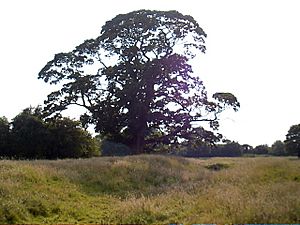Meaux Abbey facts for kids
Meaux Abbey was a large and important Cistercian abbey (a type of religious community for monks) in England. It was founded in 1151 near Beverley in the East Riding of Yorkshire. The abbey was also known by its older name, Melsa.
Contents
What Was Meaux Abbey?
Meaux Abbey was a home for monks who followed the Cistercian way of life. This meant they lived simply, worked hard, and prayed often. The abbey was founded by a powerful man named William le Gros, 1st Earl of Albemarle. He held important titles like Count of Aumale, Earl of York, and Lord of Holderness. These titles showed he was a very important noble in England during the 12th century.
A Look at Its History
The story of Meaux Abbey was written down in a special book called a chronicle. This chronicle was created by Thomas Burton, who was one of the abbey's abbots (the leader of an abbey). This book helps us understand what life was like at Meaux Abbey and what important events happened there.
Meaux Abbey and Kingston upon Hull
Meaux Abbey owned a lot of land, including an area called Wyke. In 1293, King Edward I of England bought this land from the abbey. He wanted to build a new town there, which became known as Kingston upon Hull. This shows how important the abbey was, owning land that a king wanted for a new city.
The End of Meaux Abbey
Meaux Abbey was closed down in 1539 by King Henry VIII. At this time, King Henry VIII was closing many monasteries across England. This event is known as the Dissolution of the Monasteries. After it was closed, the abbey was pulled down, or demolished. The stones from the abbey were then used to build strong walls and other defences for the new town of Kingston upon Hull.
What Remains Today?
Today, you can't see the full buildings of Meaux Abbey. Only earthworks, which are changes in the shape of the land, are visible. These show where the abbey once stood. The site of Meaux Abbey is now a Scheduled Ancient Monument. This means it's a very important historical place that is protected by law.


